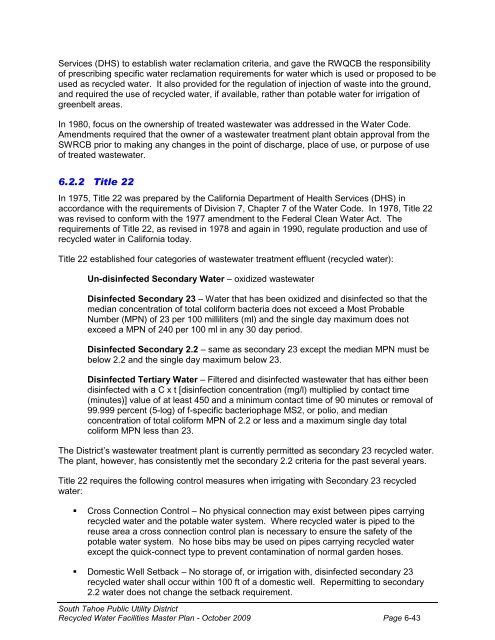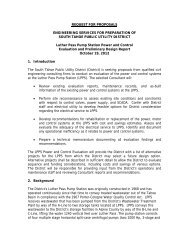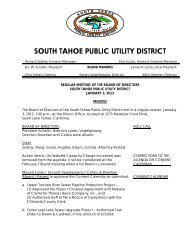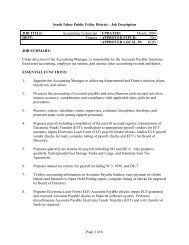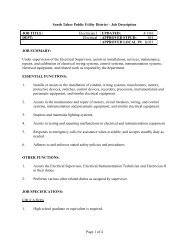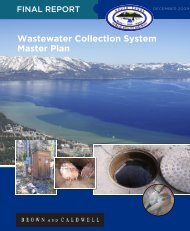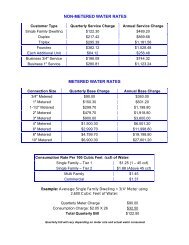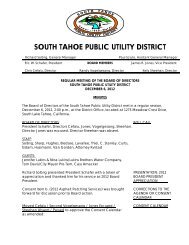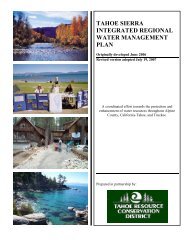October 2009 - South Tahoe Public Utility District
October 2009 - South Tahoe Public Utility District
October 2009 - South Tahoe Public Utility District
Create successful ePaper yourself
Turn your PDF publications into a flip-book with our unique Google optimized e-Paper software.
Services (DHS) to establish water reclamation criteria, and gave the RWQCB the responsibility<br />
of prescribing specific water reclamation requirements for water which is used or proposed to be<br />
used as recycled water. It also provided for the regulation of injection of waste into the ground,<br />
and required the use of recycled water, if available, rather than potable water for irrigation of<br />
greenbelt areas.<br />
In 1980, focus on the ownership of treated wastewater was addressed in the Water Code.<br />
Amendments required that the owner of a wastewater treatment plant obtain approval from the<br />
SWRCB prior to making any changes in the point of discharge, place of use, or purpose of use<br />
of treated wastewater.<br />
6.2.2 Title 22<br />
In 1975, Title 22 was prepared by the California Department of Health Services (DHS) in<br />
accordance with the requirements of Division 7, Chapter 7 of the Water Code. In 1978, Title 22<br />
was revised to conform with the 1977 amendment to the Federal Clean Water Act. The<br />
requirements of Title 22, as revised in 1978 and again in 1990, regulate production and use of<br />
recycled water in California today.<br />
Title 22 established four categories of wastewater treatment effluent (recycled water):<br />
Un-disinfected Secondary Water – oxidized wastewater<br />
Disinfected Secondary 23 – Water that has been oxidized and disinfected so that the<br />
median concentration of total coliform bacteria does not exceed a Most Probable<br />
Number (MPN) of 23 per 100 milliliters (ml) and the single day maximum does not<br />
exceed a MPN of 240 per 100 ml in any 30 day period.<br />
Disinfected Secondary 2.2 – same as secondary 23 except the median MPN must be<br />
below 2.2 and the single day maximum below 23.<br />
Disinfected Tertiary Water – Filtered and disinfected wastewater that has either been<br />
disinfected with a C x t [disinfection concentration (mg/l) multiplied by contact time<br />
(minutes)] value of at least 450 and a minimum contact time of 90 minutes or removal of<br />
99.999 percent (5-log) of f-specific bacteriophage MS2, or polio, and median<br />
concentration of total coliform MPN of 2.2 or less and a maximum single day total<br />
coliform MPN less than 23.<br />
The <strong>District</strong>‟s wastewater treatment plant is currently permitted as secondary 23 recycled water.<br />
The plant, however, has consistently met the secondary 2.2 criteria for the past several years.<br />
Title 22 requires the following control measures when irrigating with Secondary 23 recycled<br />
water:<br />
• Cross Connection Control – No physical connection may exist between pipes carrying<br />
recycled water and the potable water system. Where recycled water is piped to the<br />
reuse area a cross connection control plan is necessary to ensure the safety of the<br />
potable water system. No hose bibs may be used on pipes carrying recycled water<br />
except the quick-connect type to prevent contamination of normal garden hoses.<br />
• Domestic Well Setback – No storage of, or irrigation with, disinfected secondary 23<br />
recycled water shall occur within 100 ft of a domestic well. Repermitting to secondary<br />
2.2 water does not change the setback requirement.<br />
<strong>South</strong> <strong>Tahoe</strong> <strong>Public</strong> <strong>Utility</strong> <strong>District</strong><br />
Recycled Water Facilities Master Plan - <strong>October</strong> <strong>2009</strong> Page 6-43


